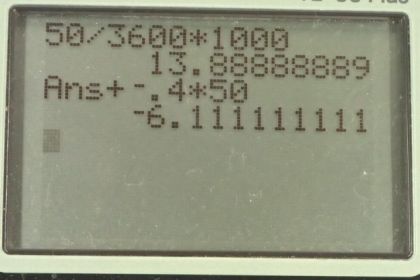Question
Unreasonable Results (a) What is the final velocity of a car originally traveling at 50.0 km/h that decelerates at a rate of for 50.0 s? (b) What is unreasonable about the result? (c) Which premise is unreasonable, or which
premises are inconsistent?
Final Answer
- The final velocity is backwards. This might be possible if the car was stopped and reversed using the transmission and clutch.
- The duration is longer than necessary to stop.
Solution video
OpenStax College Physics for AP® Courses, Chapter 4, Problem 50 (Problems & Exercises)

vote with a rating of
votes with an average rating of
.
Calculator Screenshots
Video Transcript
This is College Physics Answers with Shaun Dychko. A car is initially traveling at 50 kilometers an hour. We'll convert that into meters per second right up here where we begin by writing down the stuff that we know so that we don't have to worry about this unit conversion later. We multiply by one hour for every 3600 seconds, and the hours cancel, and we multiply by 1000 meters for every kilometer. The initial speed then is 13.89 meters per second. The acceleration we're told is backwards and so I put a negative sign to indicate that it doesn't necessarily have to be negative, we could have defined the initial velocity to be negative. The important thing is that the sign of its acceleration is opposite to the sign of the initial velocity. We have negative 0.4 meters per second squared acceleration. The time that it spends accelerating like this is 50.0 seconds. Final velocity is initial velocity plus acceleration times time, so that's 13.89 meters per second plus negative 0.4 meters per second times 50 seconds giving us a final velocity of negative 6.11 meters per second. This negative indicates that the final velocities in the opposite direction to that which the car was initially traveling, the cars going backwards in the end. The question doesn't explicitly say by what means the car is slowing down. Typically, one would be applying the brakes to do that, but it is possible to have this final result if it was a standard transmission and you had a clutch that you could use and you put the transmission in reverse maybe and the clutch was just gently rubbing and that would eventually cause the car to slow down and then go in reverse. That's possible. Part C, if we had to pick a thing that is reasonable, we have to say that this duration of 50 seconds is longer than necessary to stop and we'll assume that stopping was the goal here and that the brakes were meant to be applied.
